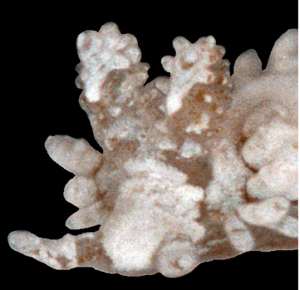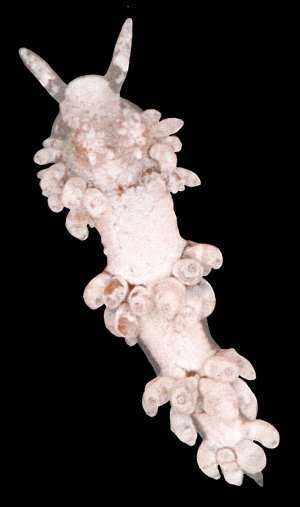Spurilla creutzbergi from the Bahamas
October 22, 2003
From: Colin Redfern

Dear Bill,
Following my other message here is another example recently collected of what I have been calling Spurilla creutzbergi from the Bahamas. The 4.5mm specimen figured in Bahamian Seashells (pl. 120, fig. 745) lacked cerata across the dorsum, which allowed the brown body to show through.
Attached are photos of the second 4.5mm specimen, which was dredged from Thalassia in 3m off Channel Cay, Abaco, Bahamas on August 20, 2003. These confirm that the body is in fact brown, although with heavy white pigmentation on the dorsum, and that the rhinophores, as described by Marcus & Marcus (1970) for S. creutzbergi, are beset with tubercles.
As noted by Edmunds & Just (1983), the cerata rock from side to side when the animal is in motion, and this movement is quite distinctive.
• Edmunds & Just. 1983. Eolid nudibranchiate Mollusca from Barbados. Journal of Molluscan Studies, 49: 185-203.
• Marcus, Er. & Ev. Marcus. 1970. Opisthobranchs from Curacao and faunistically related regions. Studies on the Fauna of Curacao and other Caribbean Islands, 33: 1-129.
Best wishes,
Colin
bahamianseashells@att.net



Thanks Colin,
This animal certainly has papillae all around the rhinophore club and so fits the Marcus description. I have included a couple of over blown-up parts of one of your photos to show the brown is almost certainly zooxanthellae in branches of the digestive gland, which apparently ramify up into the rhinophore and out on to the foot.
I didn't know what Edmunds & Just's record referred to as the gave little information, but it is interesting to both them and you noted a peculiar rhythmical movement of the cerata. It joins with Aeolidiella alba and Limenandra nodosa as another member of the Aeolidiidae with very noticeable rhythmical waving of their cerata.
It's a pity that the original description of this species was so lacking in information, but the tuberculate rhinophores certainly suggest Ross Gundersen's animal, is not Spurilla creutzbergi.
Best wishes,
Bill Rudman
Related messages
-
New records from Brazil [2]
From: Vinicius Padula, August 23, 2007 -
Spurilla creutzbergi? from Jamaica
From: Ross W. Gundersen, October 22, 2003 -
Aeolid from Florida?
From: Angelo, November 14, 2002
